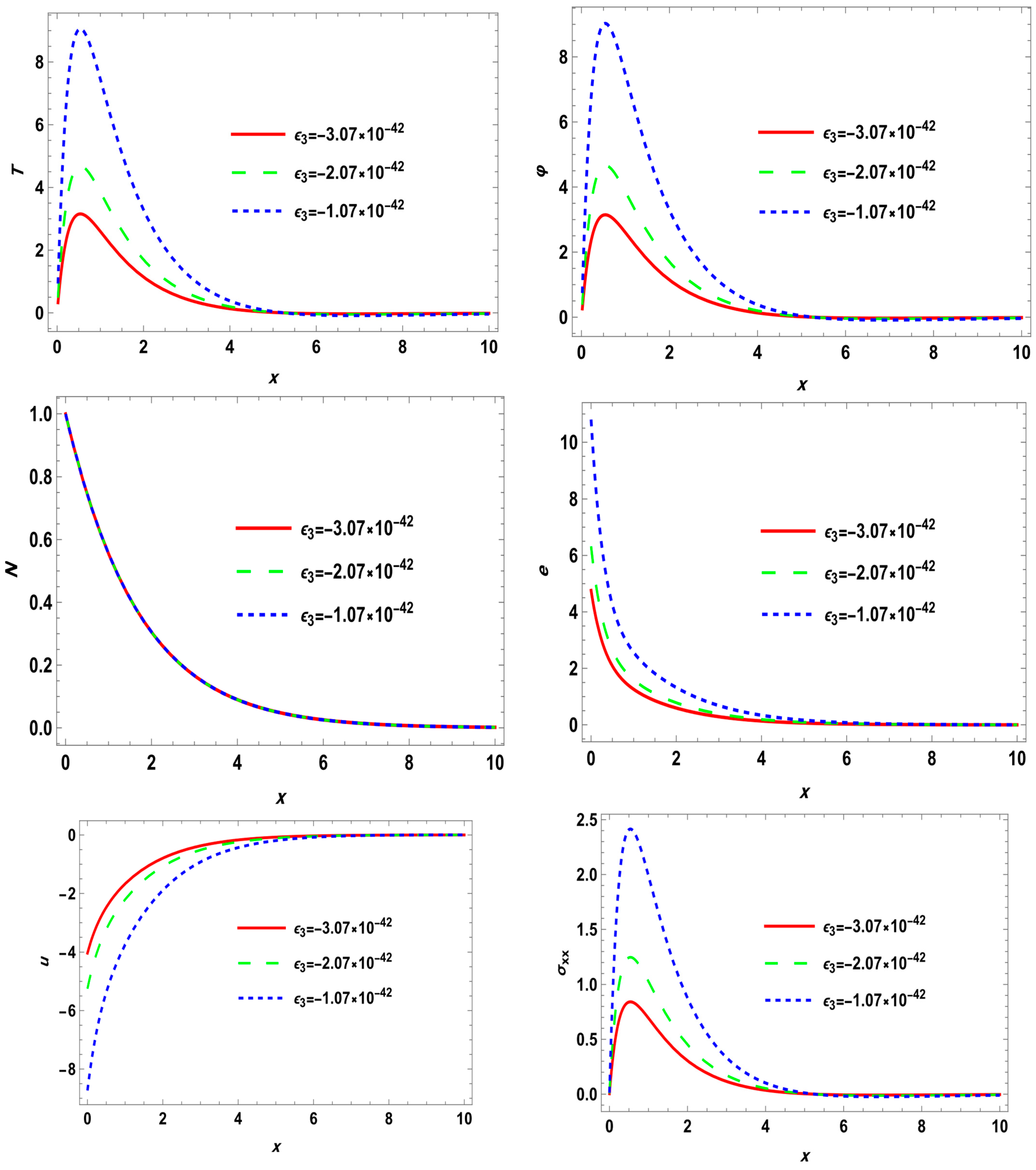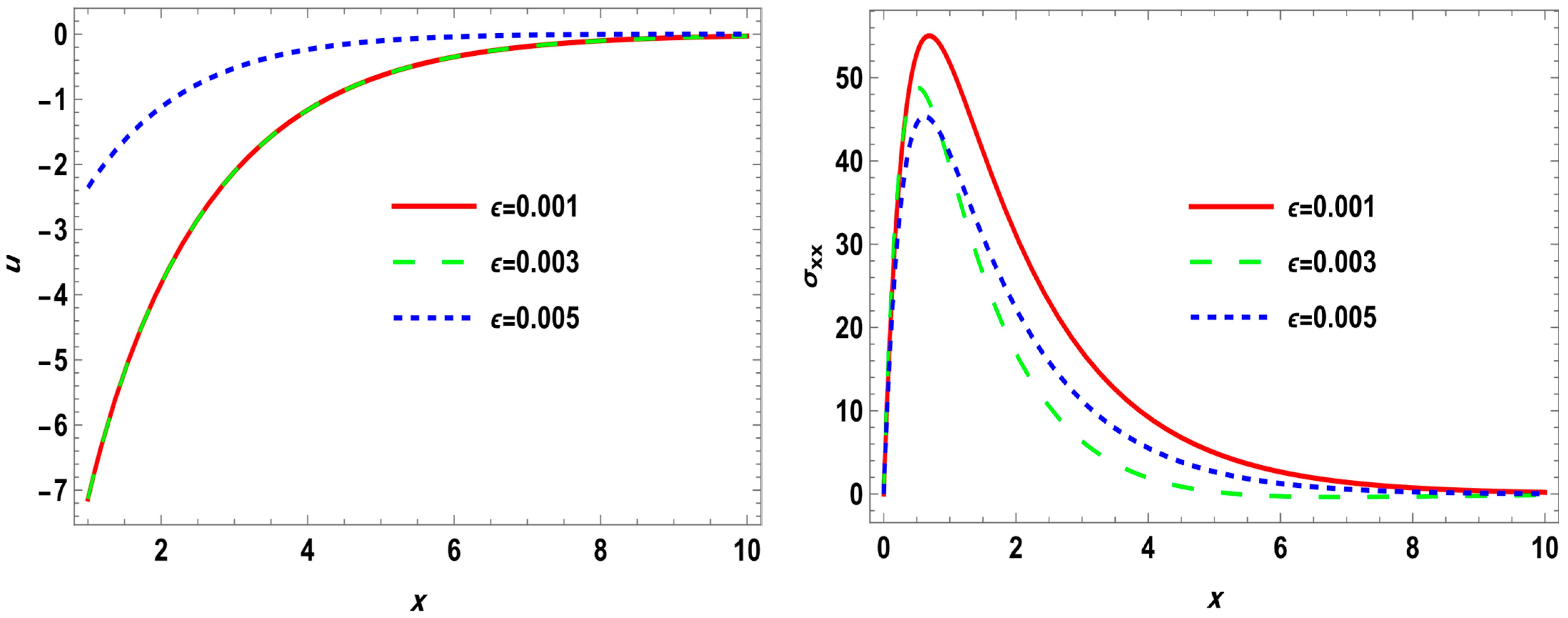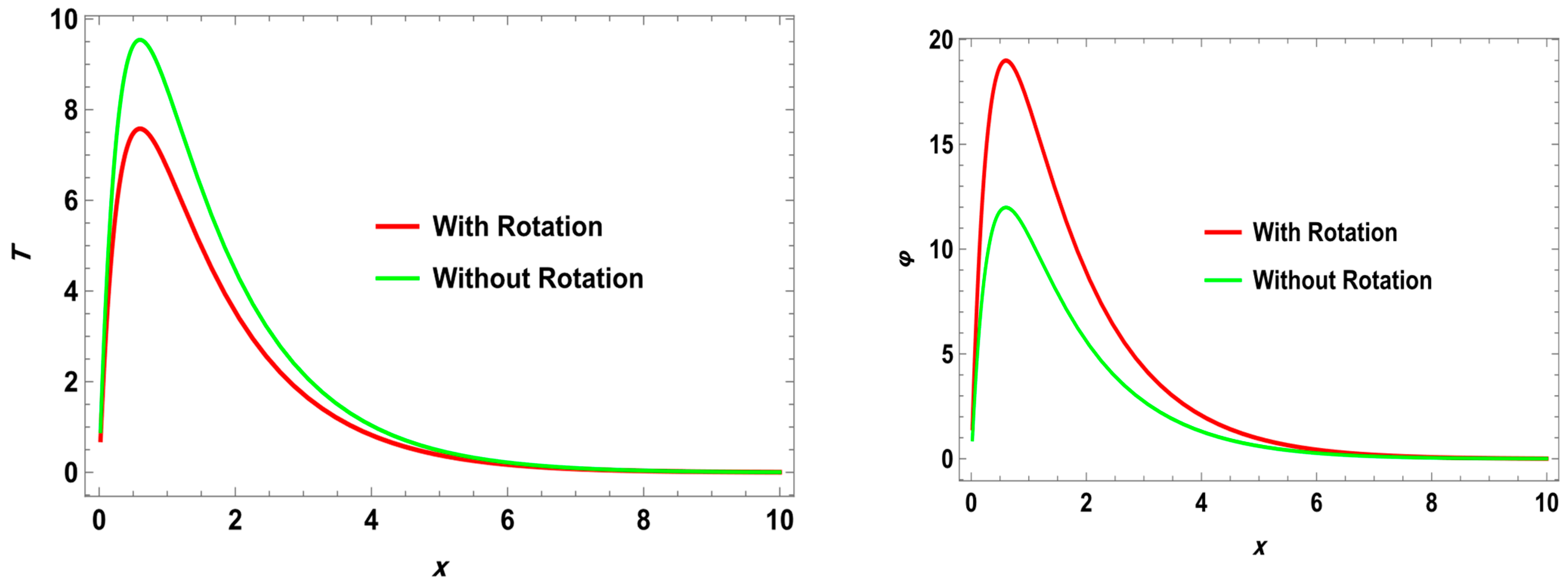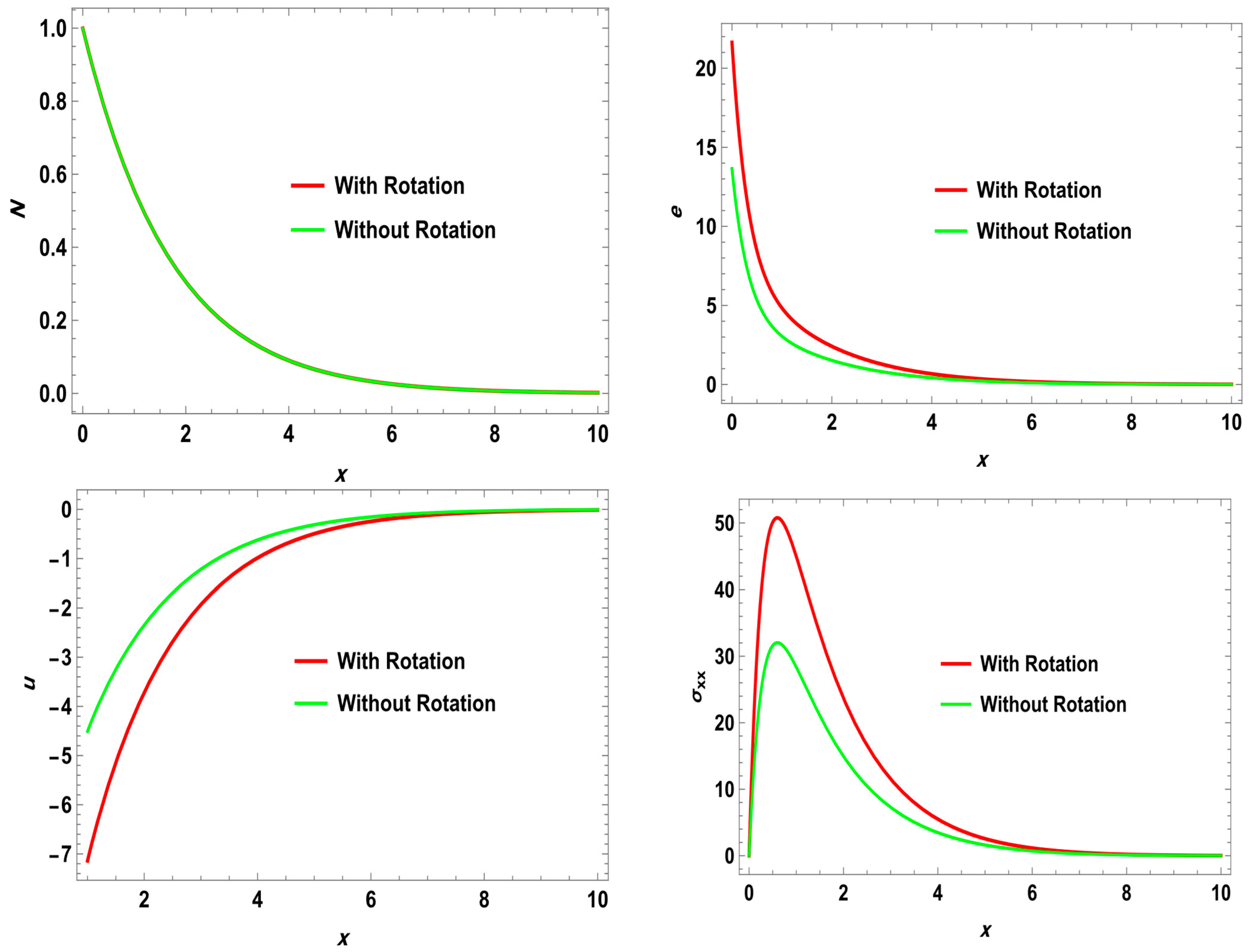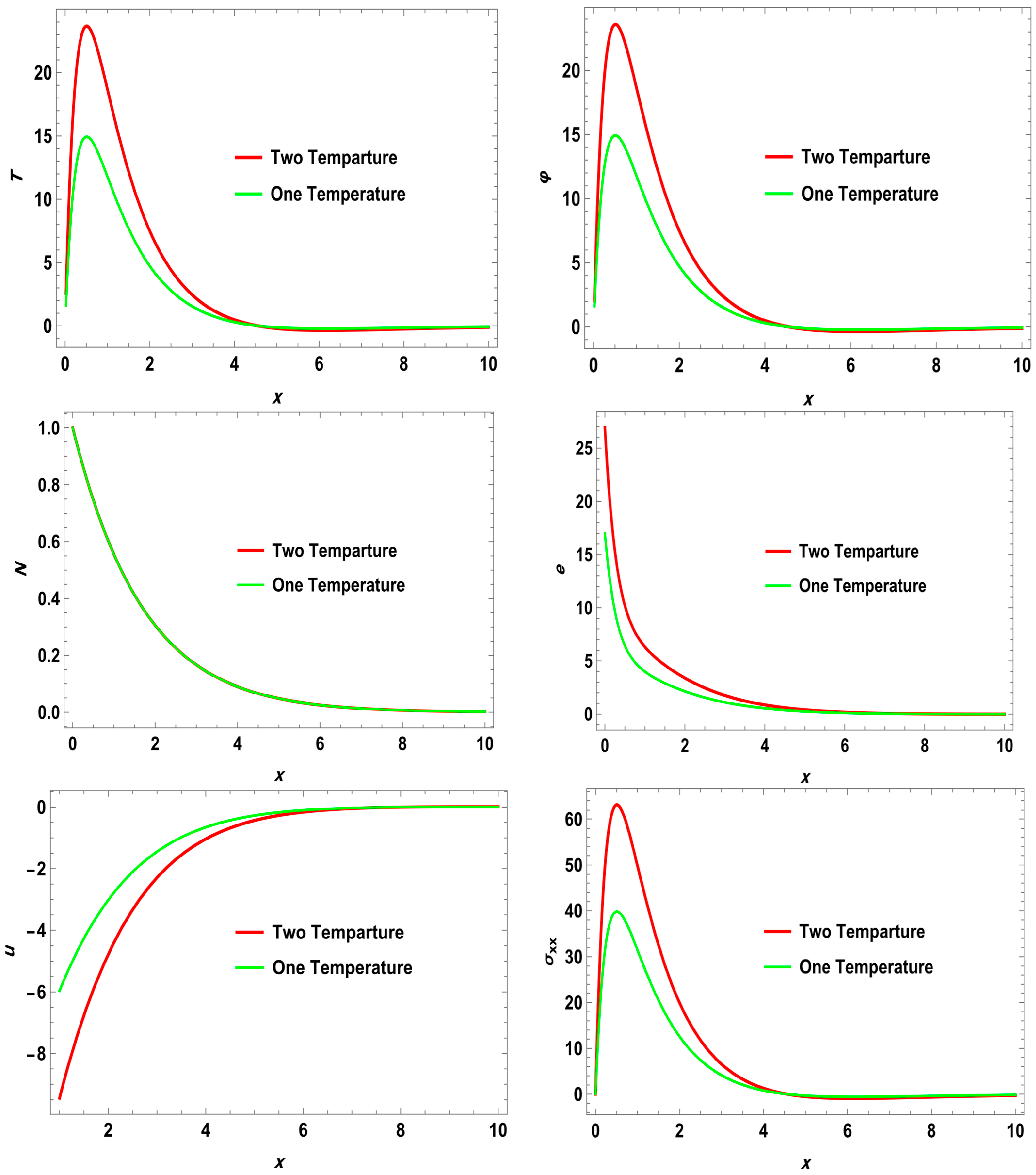1. Introduction
The thermoelastic behavior of semiconductor nanostructures under dynamic thermal and mechanical loads has garnered significant attention due to its implications for microelectronics, optoelectronics, and nanoscale energy transport. This study examines the coupled effects of rotation, ramp-type heat sources, and two-temperature thermodynamics on wave propagation in semiconducting thermoelastic solids, addressing a critical gap in the understanding of transient thermo-mechanical interactions in rotating nanostructures. Unlike classical thermoelasticity, the two-temperature model (TTM) decouples the conductive temperature from the thermodynamic temperature, enabling a more accurate description of thermal wave propagation in semiconductors, where nonlocal effects dominate at nanoscales. The inclusion of rotation introduces Coriolis and centrifugal forces, which modify elastic wave characteristics (e.g., phase velocity, attenuation) and thermal diffusion patterns, while the ramp-type heat source—a time-dependent thermal load—mimics realistic laser heating or pulsed thermal excitation scenarios. By formulating the governing equations within the TTM framework and solving them analytically/numerically, this work elucidates how rotation alters thermoelastic energy dissipation, wave dispersion, and temperature gradients in semiconductor nanomaterials. The results provide foundational insights for designing rotating semiconductor devices (e.g., MEMS sensors, nanogenerators) subjected to abrupt thermal loads, where conventional single-temperature models fail to capture experimental observations. Interactions between thermal fields, elastic fields, and semiconducting fields have recently received increased attention due to their practical applications in fields as varied as geophysics, geology, acoustics, engineering, and aerospace. Several articles have investigated the role of nanostructure in the thermoelasticity of materials. Tang et al. [
1] present a new constitutive equation for thermoelasticity in crystals and demonstrate its accuracy through calculations on copper and graphene. Micropolar thermoelastic solids are included in the entropy production inequality by Dost and Tabarrok [
2], who demonstrate that the energy equation takes on a hyperbolic shape and displays wave characteristics. Kim et al. [
3] show that embedding ErAs nano islands in In/sub 0.53/Ga/sub 0.47/As decreases heat conductivity below the alloy limit and boosts thermoelectric figure of merit. This may be due to the nano islands scattering mid- to long-wavelength phonons. Nowacki [
4] discusses the propagation of surfaces of discontinuity in thermoelastic solids, including weak and strong thermoelastic waves of different orders.
To take into consideration the consequences of nonlocal behavior in heat conduction, the field of solid mechanics known as nonlocal thermoelasticity was developed. Nonlocal thermoelasticity takes into account the nonlocal character of heat transport at tiny scales, in contrast to standard heat conduction theories based on Fourier’s equation. According to Fourier’s law, which governs classical heat conduction, the heat flux at any given site is directly proportional to the local temperature gradient. However, at very small scales, nonlocal interactions between surrounding atoms or molecules allow for thermal transfer to occur.
Nonlocal thermoelasticity has gained significant attention in recent years due to the development of nanotechnology and miniaturization of devices, where heat transfer at small scales becomes crucial. It is also relevant in materials with highly heterogeneous microstructures, such as composites or porous media, where the traditional local heat transfer models fail to capture accurately the thermal behavior. The nonlocal theory of heat conduction considers the integral form of Fourier’s law, where the heat flux is expressed as an integral of the temperature gradient over a certain range. The range of integration, known as the nonlocal length scale, represents the characteristic distance over which the heat transfer occurs nonlocally. This nonlocal length scale can be determined experimentally or through theoretical approaches, such as molecular dynamics simulations or statistical mechanics.
Nonlocal thermoelasticity has been extensively studied in various applications, including heat conduction in nanowires, thin films, and biological systems. It has also found application in the analysis of microscale electronic devices, such as transistors and integrated circuits, where the accurate prediction of the temperature distribution and heat dissipation is crucial for device performance and reliability.
In thermoelasticity, the concept of rotation with nonlocal effects refers to the consideration of the rotational displacement field and the incorporation of nonlocal effects in the analysis of thermomechanical behavior. Thermoelasticity deals with the coupling between thermal and mechanical phenomena in solids, where temperature changes induce mechanical deformations and vice versa. Traditionally, in classical elasticity, the displacement field is described by the translation of material points without considering rotation. However, in certain cases, rotations of material elements cannot be neglected, especially in small-scale structures or when dealing with non-homogeneous materials. The consideration of rotation in thermoelasticity allows for a more accurate description of the deformation behavior, particularly in cases where the rotation field significantly influences the thermomechanical response. Nonlocal effects in thermoelasticity refer to the incorporation of nonlocal operators or integral formulations to model the dependence of the deformation field on the behavior of neighboring material points. Nonlocal operators take into account the spatial variations in the deformation field and provide a means to capture the effects of long-range interactions between material points, which are often ignored in classical elasticity.
The study of rotation with nonlocal effects in thermoelasticity is an active area of research, with applications in various fields such as micro- and nano-electromechanical systems, materials science, and biomechanics. Researchers are investigating the theoretical foundations, mathematical modeling, numerical methods, and experimental validations of these concepts.
Thermoelasticity relies heavily on rotation. Several investigations have looked into what happens to thermoelastic materials when they are rotated. For an isotropic elastic material at two temperatures, El-Sapa et al. [
5] constructed a generalized micropolar thermo-visco-elasticity model, taking rotation and viscosity into account. Considering the influence of rotation, Mashat et al. [
6] proposed a model for generalized thermoelasticity with phase-lags in an orthotropic body including a spherical cavity. Using Lord–Shulman’s theory and the classical dynamically linked theory, for a homogeneous isotropic elastic half-space solid, Sarkar [
7] studied the effects of rotation on the equations of generalized thermoelasticity. Abo-Dahab used multiple thermoelastic theories to examine how rotation affects a generalized thermoelastic half-space with diffusion, electromagnetic field, and gravity field [
8]. Lotfy et al. [
9] investigated the effect of rotation on the thermoelastic half-space using the theory of two-temperature generalized thermoelasticity. Sharma et al. [
10] investigated plane wave reflection in the generalized thermoelastic half-plane, considering rotation and starting stress. In the presence of rotation and “initial stress in thermoelasticity”, the reflection coefficient was found.
The thermoelastic effects of rotation and magnetic field have been the subject of several articles. Four distinct theories, namely the coupled theory (CT), the Lord–Schulman (LS) theory, the Green–Lindsay (GL) theory, and the Green–Naghdi (GN) theory, have been examined to comprehend the impact of rotation and magnetic field on the generalized thermoelasticity equations for a uniform isotropic elastic half-space [
11]. The impact of diffusion in gaps in an extended thermoelastic half-space subjected to a magnetic field, gravity field, and rotation is modeled mathematically in [
8]. Transient waves from a line heat source have been investigated in a rotating half-space fiber-reinforced thermoelastic medium [
12]. This study investigates the influence of magnetic field and rotation on a two-dimensional problem of fiber-reinforced thermoelasticity in a homogeneous isotropic elastic half-space by the application of normal mode analysis [
13]. Harmonic wave propagation in a rotating nonlinear magneto-thermoelastic medium has been simulated using homotopy perturbation and variational iteration [
14].
The effects of rotation and magnetic fields on nonlocal thermoelasticity have been the subject of numerous papers. The effects of a rotating magnetic field on the free oscillations of an elastic hollow sphere were studied by Bayones et al. [
15]. Both the magnetic field and the rotation were shown to have significant effects on the wave dispersion curves. Al-Basyouni and Mahmoud [
16] discussed the effect of the magnetic field, initial stress, rotation, and nonhomogeneity on stresses in orthotropic material. The planar strain two-temperature problem in a semiconducting medium was studied by Abo-dahab and Lotfy [
17] using photothermal theory. Using nonlocal modified couple stress theory and generalized thermoelastic theory, Yahya et al. [
18] studied thermoelastic rotating nanobeams subjected to periodic pulse heating. Liu et al. [
19] investigated the photothermal phenomenon: extended ideas for thermophysical property characterization. Different field variables were tested for their sensitivity to rotation and pair stress. This body of research, taken as a whole, sheds light on how rotation and magnetic field affect nonlocal thermoelastic behavior. The photothermal phenomena were the subject of research in [
19]: expanded ideas for characterizing thermophysical qualities. The wave propagation in thermoelastic via semiconductor nanostructure by a ramp heat source was studied by Abo-Dahab et al. [
20]. Mondal and Sur [
21] discussed the photo-thermo-elastic wave propagation in an orthotropic semiconductor with a spherical cavity and memory responses. Ezzat [
22] studied hyperbolic thermal–plasma wave propagation in a semiconductor of organic material. Ezzat [
23] investigated a novel model of fractional thermal and plasma transfer within a non-metallic plate. Hirdes and Honig’s method for numerically inverting Laplace transforms was explored in [
24]. El-Sapa et al. [
25] examined the effect of moisture diffusivity on the photothermal excitation process in semiconductor materials. The authors of [
26] investigated the photothermal excitation mechanism in a magneto-thermoelastic medium using hyperbolic two-temperature theory. One-dimensional applications of fractional generalized thermoelasticity related to two relaxation durations were described by Hamza et al. The authors of [
27,
28] highlighted the fractional derivative heat transport and nonlocal theory of thermoelastic materials with voids. Functionally graded (FG) magneto-photo-thermoelastic semiconductor materials using hyperbolic two-temperature theory were examined by Saeed et al. [
29].
Recent studies from 2024 also continue to advance this field. For example, Marin and Abbas [
30] extended thermoelastic void models with fractional operators; Lotfy et al. [
31] examined noise-influenced photoacoustic wave interactions; and Saeed et al. [
29] developed magneto-photothermal models in FG semiconductors under stochastic excitation.
In this article, the rotational and ramp-type heat source on wave propagation in a semiconductor nanostructure thermoelastic solid is studied. A generalized thermoelastic theory, along with coupled nonlocal elastic theory, is formulated as a mathematical model representing the phenomena. Incorporating a ramp-type heat equation of fractional order allows us to point out the influence of temperature on wave motion. The decomposition method is used to separate the governing equations into their longitudinal and transverse parts. It is obvious that one longitudinal P-type and secondary shear S-type three waves are propagating through the medium. For a given material, analytical results for the reflection coefficient of each of the transmitted waves are computed numerically and then displayed graphically. The influence of rotation, nonlocal parameters , and time derivative fractional order (FO) is also discussed.
Although significant efforts have been made to model thermoelastic wave propagation in semiconducting media under various conditions—such as rotation [
9], photothermal excitation [
20], fractional derivatives [
27], and two-temperature frameworks [
26]—most existing studies consider these effects in isolation or limited combinations. For example, Lotfy et al. [
9] examined rotational effects using two-temperature thermoelasticity but without ramp-type or fractional heating, while Abo-Dahab et al. [
20] studied ramp-type photothermal heating in semiconductors but excluded rotation and nonlocal elasticity.
The present study distinguishes itself by integrating four key mechanisms—(i) mechanical rotation, (ii) ramp-type heat input modeled using fractional derivatives, (iii) the two-temperature theory, and (iv) nonlocal thermoelasticity—within a unified analytical framework. This comprehensive formulation enables us to investigate the intricate coupling between thermal, elastic, and electronic fields under realistic nanoscale conditions, including Coriolis and centrifugal forces, phase-lag heat conduction, and long-range atomic interactions. To the best of our knowledge, this is the first work to explore these combined effects analytically using Laplace–Fourier inversion techniques for semiconductor nanostructures. As such, our model offers enhanced predictive capabilities for next-generation optoelectronic and microelectromechanical (MEMS) devices subjected to dynamic multi-physical loads.
While our earlier studies have addressed some individual aspects (e.g., rotation or ramp heating), the present work is the first to combine all of the following mechanisms: (i) mechanical rotation with Coriolis effects, (ii) fractional-order ramp-type heating, (iii) nonlocal thermoelasticity, and (iv) the two-temperature model. This unified framework allows us to reveal emergent interactions between thermal, mechanical, and plasma fields not captured in any prior work. No previous study, including those by the authors, has treated this specific configuration analytically using Laplace–Fourier techniques.
2. Basic Equations
Assume that the medium being analyzed is uniformly rotating; in this case, the angular velocity is and is a unit vector explaining the direction of the rotation axis. The equation of motion in the rotating reference frame contains two supplementary terms:
(1) Centripetal acceleration, due to time-varying motion only.
(2) The acceleration of Coriolis , where is the displacement vector.
In a problem that involves only one dimension, every variable is solely dependent on coordinate x and time t. We considered the angular velocity as . On the other hand, when there is no rotation, these terms are absent in the medium.
Consider the transport mechanism of plasma in a semiconductor nanostructure medium, the time derivative fractional-order thermoelastic model, and the equation of motion. By applying the principle of nonlocal theory, quantity
is brought in, where
describes the nonlocal effect, and
is the material characteristic length. Semiconductor and isotropic media are under consideration. The carrier density
N (
, t), temperature distribution T (
, t), and elastic displacement
u (
, t) are the main variable quantities. The equation of motion for a plasma wave that is subject to hydrostatic initial stress without body force is determined. In this analysis, the plasma transport equation with a new model under two-temperature theory [
22] and the heat conduction model [
14] is as follows:
The fractional-order time derivative α appearing in Equation (3) accounts for non-Fourier, memory-dependent heat conduction, especially relevant at micro- and nanoscales. Physically, α < 1 reflects subdiffusive thermal behavior, where the energy carriers (e.g., phonons, hot electrons) experience scattering, trapping, or delayed release during transport. Such behavior is often observed in semiconductor heterostructures, amorphous systems, or nano-layered materials. An experimental estimation of α can be achieved via ultrafast thermoreflectance measurements or by the inverse modeling of time-domain photothermal response curves (see Ezzat [
22] and Liu et al. [
19]).
The displacement and strain tensor equation looks like this:
In a thermoelastic, isotropic, semiconducting medium, the stress–strain relationship is written as follows:
Here is an expression for the connection between local and nonlocal theories of stress:
where
represents the Cauchy’s stress tensor at any point of the body, and
is the nonlocal stress tensor at the reference point. By contrasting the formulas for wave frequencies in the nonlocal model with those in the Born–Karman model of lattice dynamics, the correctness of Equation (6) has been demonstrated,
which is the Kronecker delta.
is the temperature,
is the carrier density,
is the displacement distribution,
indicates the position vector,
represents carrier diffusion coefficients,
is the density,
is the photo-generated carrier lifetime, and
represent the coefficients of specific heat and thermal conductivity, respectively.
are Lame elastic constants, and
is the energy gap of the semiconductor parameter.
is the volume thermal expansion.
is the coefficient of linear thermal expansion.
is the coefficient of electronic deformation,
is the coupling parameter for thermal activation, and
is the carrier concentration at the equilibrium position. The boundary conditions for the elastic surfaces of the semiconductor
(taken as a rod) under electrical short (closed circuit) and stress loads are isothermal and are governed when the boundary conditions on the surface are thermally insulated.
The relation between heat conduction and dynamical heat takes the form
where
> 0 is the two-temperature parameter (Youssef [
32]).
The constitutive law of the theory of generalized thermoelasticity takes the following form:
We can define the physical quantities in one dimension (1D) using the following expressions:
The following constitutive equation in 1D takes the form
5. Boundary Conditions
To specify certain parameters , suppose that an elastic semiconductor material is subjected to different mechanical, plasma, and thermal loads on its external surface. In all scenarios, the Laplace transforms are utilized.
(I) The free surface is subjected to thermal shock and acts as the isothermal boundary condition for a thermally isolated system when
:
(II) Laplace transformation used to analyze free-surface mechanical normal stress components when
results in
(III) When the diffusion of carrier density and the photo-generation during recombination processes are being transported, the plasma boundary condition at the free surface
can be expressed differently by using the Laplace transform. Here, the plasma condition takes the following form:
In contrast, we found this connection:
The equations above use symbols and that indicate the Heaviside unit step function, with a chosen constant represented by the symbol . We can obtain the unknown parameters by solving these equations in terms of the parameters.
For the simulations, the ramp-type thermal input is defined in the time domain as
where
is the heating rate and
is the ramp duration. Its Laplace transform is
The photo-generation boundary function
is modeled as exponential saturation:
It is important to note that the boundary conditions employed in this study are idealized as homogeneous (zero displacement, zero stress, thermally insulated or isothermal), which simplifies the mathematical formulation and facilitates analytical tractability. However, in practical applications—such as laser-irradiated semiconductor wafers, MEMS devices, or photothermal imaging systems—inhomogeneous or mixed boundary conditions (e.g., convective heat loss, applied surface tractions, or time-dependent thermal pulses) are more representative of realistic environments. While the current model captures the fundamental behavior of wave propagation and field interactions under ideal constraints, deviations from real-world setups may arise, particularly near surfaces or interfaces. These differences could manifest in altered amplitude, phase shifts, or localized field enhancements. Future work may extend this model to incorporate more complex and physically relevant boundary conditions, such as Robin-type thermal conditions, nonlinear mechanical constraints, or spatially varying plasma boundary terms, thereby enhancing predictive accuracy and practical applicability.

